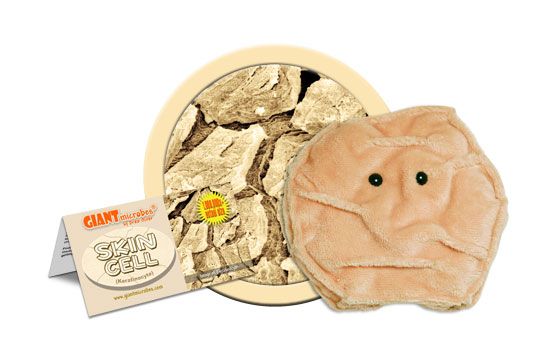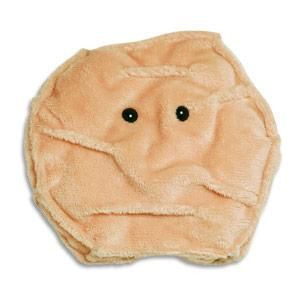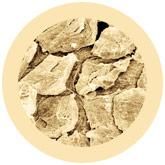Skin Cell (Keratinocyte)

Letters to a Pre-Scientist connects 5th - 10th grade student “pre-scientists" from low-income communities with real scientists as pen pals. The mission is to demystify science careers by creating personal connections between students and real scientists.
5% of the proceeds from your purchase will be donated to LPS.
Product Details
Additional Information
| Sizes | Giantmicrobes are based on actual microbes, cells, organisms and other critters, only 1,000,000 times actual size! Gigantic (GG) 16-24" XL (XL) 10-15" Original (PD) 5-8" Keychain (KC) 2-4" with clip |
|---|---|
| Materials | Plush from all new materials. Stuffed with polyester fiber fill. Surface washable: sponge with water & soap, air dry. |
| Packaging | Each plush microbe includes a printed card with fun, educational and fascinating facts about the actual microbe or cell. |
| Safety | Every product meets or exceeds U.S. and European standards for safety. For ages 3 and up. |
All about Skin Cell (Keratinocyte)
FACTS: Beauty may be only skin deep, but your skin is more than just another pretty face: it’s your largest organ, and your first line of defense against the outside world!
The skin has three layers. The top layer, or epidermis, is made primarily of tough keratinocyte cells that ward off everything from pathogens to blunt objects – and also prevent vital water and nutrients from escaping. These cells are born near the edge of your body’s network of blood vessels. Over the course of a month, they are pushed away from the blood supply by even newer cells until they die and slough off. Tens of thousands of skin cells flake off your body every minute – nearly 10 pounds each year!
The epidermis also contains pigment-producing melanocyte cells that give your skin its color. Darker skin provides increased protection from the sun’s UV rays, but lighter skin allows for increased production of bone-strengthening Vitamin D when the sun is less bright. (A suntan is the body’s way of trying to limit its exposure to the sun.)
Beneath the epidermis, the dermis layer contains the blood vessels that help regulate temperature and the nerves that allow you to feel heat and touch. In addition, the dermis supports the oil and sweat glands that keep the skin lubricated and waterproof, and acts as an anchor for your hair follicles – all critical to keeping you warm, dry, and looking good.
Finally, a thin layer of subcutaneous fat cells provides you with a measure of insulation and food storage – and which naturally keeps your body from getting too … skinny!
| Description | Skin cells are the outermost layer of protection for the body. The skin protects against pathogens and excessive water loss. It maintains a constant temperature by sweating when necessary, and it has nerve endings for sensing touch. This is a nice gift for a dermatologist, teacher, or anybody interested in anatomy! |
|---|
| Name |
Keratinocytes get their name because they produce the protein Keratin, and –cyte is the ending indicating that it is a “cell.” The same construction is true for Melanocytes, which make melanin. Merkel cells and Langerhans cells are named after the scientists that discovered them. Types: Keratinocytes: are the skin cells on the outermost layer, the ones that we see. They produce keratin, a protein that helps to strengthen the barrier. Melanocytes: produce melanin, the pigment of the skin. Merkel Cells: help you sense touch. Langerhans Cells: work to protect the body against pathogens. To help the immune system, they bind to antigens that try to come through the skin. |
|---|
| Actual Size | 30 microns, comparable to the diameter of the finest pieces of human hair. |
|---|
| System | Integumentary System: protects the body from damage. |
|---|
| History |
1868: Paul Langerhans was the first to describe Langerhans cells. Only later was their immune role recognized. 1875: Friedrich Sigmund Merkel, a German scientist, was the first to describe touch cells, later named Merkel cells, in the skin of vertebrates. |
|---|
| Fascinating Facts |
Dead Skin: You shed between 30,000-40,000 skin cells every minute! Self-Renewal: Skin renews itself once every 35 days. Skin is the largest organ in the body! In Culture: Skin: a stage name for Deborah Anne Dryer who is the lead singer of the British band Skunk Anansie. Skin: a 2008 movie about a black girl with two white Afrikaner parents. Skin: a song by Rihanna on her 2010 album “Loud.” |
|---|








